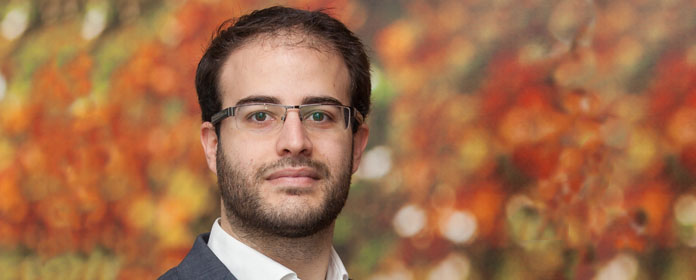News
LATEST NEWS AND EVENTS FROM THE SCHOOL OF ENGINEERING
"To prevent fake news from going viral, you have to monitor it to detect when it starts to grow exponentially."
The engineer and consultant Pablo Urruchi, Deputy Director of Master's Degree in Big Data Science at the University of Navarra, explains in a webinar at campus in Madrid how a pandemic in communication works.

PHOTO: Manuel Castells
"To prevent fake news from going viral, you have to monitor it as soon as you detect the first signs of exponential growth, when the numbers are still small. The moment they are widely spread, control is lost". So says the engineer and consultant Pablo Urruchi, researcher of the Institute of Data Science and Artificial Intelligence and Deputy Director of the Master in Big Data Science at the University of Navarra.
On April 2, he gave a webinar at campus in Madrid on how a pandemic works in communication. In it he established the parallels between how information is disseminated and viruses such as Covid-19.
"To mitigate the spread of the coronavirus, governments are reducing interactions between us. Similarly, to curb the spread of information, we could use network theory: see which nodes connect communities and focus mitigation efforts on them, thus minimizing resources," he explains.
Unmasking the most sophisticated botsIn this way, he points out, it makes no sense to launch an anti-fake news campaign to the entire population because it is not effective and can lead to saturation. In response to this, he proposes "focusing on the nodes that act as bridges between communities to prevent them from being infected". He points out that these can be detected through graph theory, which is based on diagrams that represent the relationships between elements by means of points and lines.
Pablo Urruchi points out that exponentiality occurs in phenomena of nature. Bots, computer programs that perform repetitive tasks over the Internet, such as those that retweet or spread fake news, do not have this behavior. Following their trail financial aid to unmask even the most sophisticated ones, which do not meet the typical characteristics of 'bots': "They all act linearly, not exponentially".
The Deputy Director of Master's Degree in Big Data Science believes that technology companies such as Google, Facebook and Twitter could have the ability to detect hoaxes almost in real time: "Maybe they can track every tweet or post, monitor them and, as soon as they detect that there is an exponential growth, pay human attention". He stresses that, in the end, a person has to verify whether he or she is facing fake news or not. "The difference is that graph theory drastically reduces the issue of news that must be reviewed by humans," he says.
He insists on the importance of stopping fake news in time because it is not always possible for citizens to detect the origin of the information they receive. "Many media outlets make reference letter to the sources, but in channels like Whatsapp it is very difficult to check the origin of each message we receive," he points out.
In his research, Pablo Urruchi "listens" through software to conversations on Twitter and monitors how they evolve over time. He currently has around 50 channels "listening" to conversations on issues as diverse as financial stocks, politics, climate change...
"Covid-19 appears in all of them with exponential growth long before the issues have become mainstream in traditional media," he says. "For example," he says, "you're now seeing the big effects of confinement for climate change, but coronavirus has long since taken Greta Thunberg's place in the discourse on this issue.
Pablo Urruchi made these statements at the framework webinar 'Fakenews: How does a pandemic work in communication'. The activity has counted with the collaboration of the Master's Degree in Big Data Science of the University of Navarra, coordinated this course by the Institute for Culture and Society (ICS) and, starting next year, by the Institute of Data Science and Artificial Intelligence, attached to TECNUN School of Engineering.
